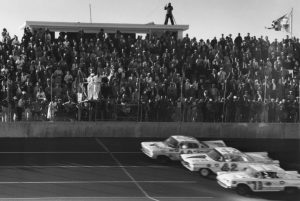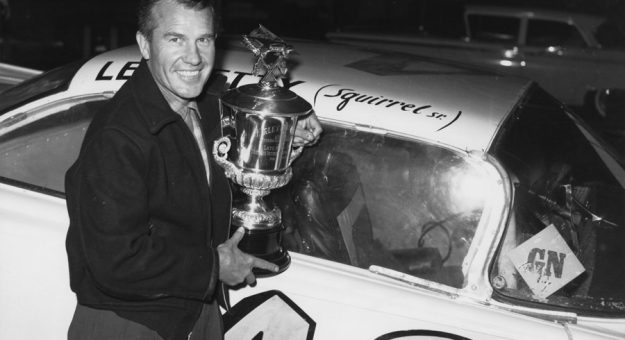Editor’s Note: NASCAR is celebrating its 75th anniversary in 2023. SPEED SPORT was founded in 1934 and was already on its way to becoming America’s Motorsports Authority when NASCAR was formed. As a result, we will bring you Part 12 of a 75-part series on the history of NASCAR as told in the pages of National Speed Sport News and SPEED SPORT Magazine.
Lee Petty’s photo-finish victory over Johnny Beauchamp on Feb. 22, 1959, in the inaugural 500-mile International Sweepstakes signified the beginning of a new era in NASCAR Grand National history.
On that day, 47,000 spectators stood for the final 15 laps of the caution-free race as Petty’s No. 42 Oldsmobile and Beauchamp’s No. 73 Thunderbird raced door-to-door around the 2.5-mile high banks. The drivers swapped the top spot back-and-forth, each leading by only a bumper or a front-side panel as they sped around the smooth track at a record average speed of 135.521 mph.
Beauchamp crossed the stripe side-by-side with Petty and was declared the victor in his 1959 Ford.
However, his victory celebration halted after conflicting finish-line reports called the decision into question. Sixty-one hours later, after NASCAR officials examined Hearst Metrotone News movies and still photographs, Petty became $19,050 richer as the inaugural victor in what later became the Daytona 500.
The defending Grand National champion wasn’t the only winner during the biggest Speedweeks in NASCAR history. On the $3 million tri-oval, 1958 rookie of the year Lloyd “Shorty” Rollins won the first race on the track, a 100-mile convertible event.
Bob Welborn captured the first Grand National event at Daytona Int’l Speedway on the same day, Feb. 20.
Publicity, Growth & New Tracks
In the April 8 edition of National Speed Sport News, Bill France said NASCAR profited from the national media coverage of the opening of the superspeedway, “The tremendous publicity we’ve enjoyed on the opening of the new speedway has spurred interest everywhere there is auto racing.”
Nearly 100,000 people paid to see February’s time trials and races at Daytona Int’l Speedway en route to a record attendance mark of 11 million at the many NASCAR-sanctioned throughout the year.
Seeking to capitalize on the interest generated by the opening of Daytona lnt’l Speedway, automobile race promoter O. Bruton Smith and NASCAR driver Curtis Turner organized two separate groups to build superspeedways near Charlotte, N.C.
Smith’s plan called for a 65,000-seat, two-mile superspeedway near Pineville, N.C. Reportedly backed by his brother-in-law, T.S. Prescott, the April 29 issue of NSSN stated Smith would begin construction on his proposed $2.25 million facility within eight weeks. Turner’s less ambitious proposal called for a 1.5-mile track on Highway 49 north of Charlotte. The estimated construction cost of his speedway was $500,000.
In the face of speculation that two major tracks could not coexist in the same city, Turner stood behind his vision: “We (Smith and he) won’t work together on this.” Smith was quoted by NSSN reporter Larry Harding as saying, “I’d like to have Curtis throw in with me … I’d like to see him as president of this thing.”
Turner and Smith compromised and constructed the 1.5-mile Charlotte Motor Speedway. Turner served as president and Smith was the executive vice president and general manager of the $2 million speedway, which was scheduled to open on May 29, 1960 with NASCAR’s longest Grand National race in history, the World 600.

The Words Usually Read, ‘Petty Wins’
On the track, Petty continued to run at or near the point. While he captured few headlines in NSSN after his breathtaking duel with Beauchamp in Daytona Beach, when his name appeared in bold print, the words usually read “Petty Wins.”
“Mr. Consistency” drove a 1957 Oldsmobile and a 1959 Plymouth to a career-high 11 victories in 42 starts. In fact, he led all drivers across the board: laps completed (8,278), laps led (1,011), miles led (4,977) and races led (16). His 35 top-10 finishes were also the most of any driver in 1959 and propelled him to his second consecutive and third overall Grand National championship.
While Petty emerged as the champion driving Oldsmobiles and Plymouths, T-Bird Power Products Co. was putting Ford Thunderbirds in the record books. A division of Charlotte-based Holman-Moody, T-Bird Power Products prepared NASCAR-legal Thunderbirds to compete on the Grand National circuit.
The cars made an immediate impact in Daytona lnt’l Speedway time trials as Curtis Turner drove his Thunderbird at 143.12 mph around the track. In qualifying, Tim Flock grabbed the International Sweepstakes 500 outside pole with a speed of 138.12 mph and Beauchamp took second in the race in his Thunderbird.
At season’s end, after five Thunderbird poles and six victories, Holman-Moody co-owner John Holman was awarded NASCAR’s Buddy Shuman award as the man who contributed the most to racing in 1959.
NASCAR’s five other divisions added four first-time champions to the record books. Joe Lee Johnson won the convertible division by 20 points over Larry Frank after a recount discovered Frank was mistakenly awarded the title. In the midget division, 23-year-old New Jersey commercial artist Jim Whitman won the crown for the second time. His first title came in 1957.
Comeback driver of the year Marvin Porter returned from major surgery to earn the short-track Grand National title. Glenn Guthrie ended the season as the modified champion and another Californian, Rick Henderson, won the sportsman laurels.
Richard Petty was named rookie of the year.
